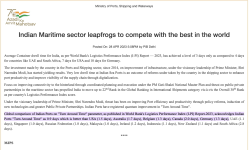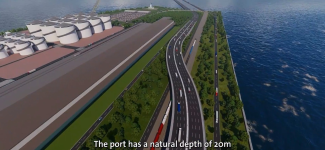Ports and shipping in India
- Thread starter RISING SUN
- Start date
You are using an out of date browser. It may not display this or other websites correctly.
You should upgrade or use an alternative browser.
You should upgrade or use an alternative browser.
U.S To transform India Into Naval Logistics Hub For Indo-Pacific Region
The United States will aid India in developing its naval and maritime infrastructure to create an Indo-Pacific regional hub for ship repairs and maintenance. Image for representation purposes only
Image for representation purposes onlyDeveloping India’s ship repair capability would also deny China from gaining its own foothold in the strategically located country.
The news came after the creation of the India-US Defense Acceleration Ecosystem, also referred to as the INDUS-X.
It was launched on 21st June when Indian Prime Minister Narendra Modi visited the U.S. The U.S. Department of Defense (D0D) issued a statement stating that INDUS-X would ‘vitalise’ the cooperation between the two nations in the defence sector.
Building and strengthening India’s maritime capability would bolster the allied forces in the Indo-Pacific.
China’s naval presence at Djibouti, Africa, Gwadar in Pakistan and Hambantota in Sri Lanka, which fell into the hands of the Chinese in 2017 following Colombo’s inability to repay China’s loans, is a key influence in the U.S. efforts to secure access to Indian maritime infrastructure.
On 22nd June, a spokesperson from the U.S. Defense Department mentioned that fostering strong defence ties between India and the U.S. was part of a ‘wide-ranging and strategic partnership’ centred on cooperation in the areas of military and national security.
Hence, an important aspect of this mutually beneficial relationship would be the development of a naval ship repair and maintenance hub in India that would be used by the U.S. and its allies.
The U.S. has a large maritime network and maritime support facilities in the Indo-Pacific.
India would become another crucial element in the United States Regional Support System.
The U.S. Navy has the support of many allies and partners in the Indian Ocean and the Pacific Region, who aid the former’s vessels in ship repair and maintenance.
The U.S. Navy’s 5th Fleet, based at U.S. Navy Support Activity at Mina Salman, Bahrain, can use several sites in the Kingdom or its neighbours for ship repair and maintenance. Its warships earlier utilised Jebel Ali, UAE, for mid-deployment voyage repairs.
Oman has top-class drydock facilities at Duqm, which can accommodate tankers far bigger than the largest U.S. Navy Warships, the Gerald Ford-class Aircraft Carriers.
The U.S. 7th Fleet based at Yokosuka in Japan can use the local ship repair facilities.
The country has deployed 4 Littoral Combat Ships at the Changi Naval Base, Singapore, where it has naval facilities for its maritime assets.

U.S To transform India Into Naval Logistics Hub For Indo-Pacific Region
The United States will aid India in developing its naval and maritime infrastructure to create an Indo-Pacific regional hub for ship repairs and maintenance.
Local ship cover may get an India club flavour
A local protection and indemnity entity supported by the government may turn out cheaper for shipping lines that currently depend on foreign entities
www.livemint.com
MSC Turkiye, world's largest green container ship, docks at Vizhinjam Port
Md Zakariya Khan
New Delhi
Last Updated: Apr 09, 2025, 6:01 PM IST
MSC Turkiye is run by the Mediterranean Shipping Company (MSC) and is considered a modern engineering wonder

MSC Turkey, world's largest container ship. (image: msc.com)
The Vizhinjam International Seaport Thiruvananthapuram today welcomed the world’s largest eco-friendly container ship, MSC Turkiye. This is the first time the massive vessel has arrived in South Asian waters, according to a report by the NDTV.
MSC Turkiye is run by the Mediterranean Shipping Company (MSC) and is considered a modern engineering wonder. The ship is 399.9 meters long, 61.3 meters wide, and 33.5 meters deep. It can carry up to 24,346 standard containers, making it one of the biggest container ships ever built.
What makes MSC Turkiye special is that it has the lowest carbon footprint per container. It uses fuel more efficiently and helps reduce pollution during sea transport.
Vizhinjam International Seaport, operated by Adani Ports and SEZ Ltd (APSEZ), is India’s first Mega Transshipment Container Terminal. It is a world-class, future-ready port and the only transshipment hub in the Indian subcontinent. The port is 10 nautical miles (19 km) from the busy international shipping route that connects Europe, the Gulf, Southeast Asia, and the Far East.
This marks a big step for India in global shipping and trade. Last year, another large ship from MSC — the MSC Claude Girardet — had also docked at Vizhinjam. That ship was slightly larger than MSC Turkiye in length but carried fewer containers.
Adani Ports and Special Economic Zone Ltd (APSEZ) is India’s largest private port company and part of the Adani Group. It runs 14 major ports and terminals across the country, including in Gujarat, Odisha, Tamil Nadu, and Kerala. The company handles all kinds of cargo like containers, coal, oil, and gas.
Known for its fast and modern operations, Adani Ports is also focused on using clean energy and reducing pollution at its ports. Its Mundra Port in Gujarat is the biggest commercial port in India, and APSEZ plays a key role in connecting India to global trade routes.
https://www.business-standard.com/i...ontainer-ship-adani-ports-125040901008_1.html
Md Zakariya Khan
New Delhi
Last Updated: Apr 09, 2025, 6:01 PM IST
MSC Turkiye is run by the Mediterranean Shipping Company (MSC) and is considered a modern engineering wonder

MSC Turkey, world's largest container ship. (image: msc.com)
The Vizhinjam International Seaport Thiruvananthapuram today welcomed the world’s largest eco-friendly container ship, MSC Turkiye. This is the first time the massive vessel has arrived in South Asian waters, according to a report by the NDTV.
MSC Turkiye is run by the Mediterranean Shipping Company (MSC) and is considered a modern engineering wonder. The ship is 399.9 meters long, 61.3 meters wide, and 33.5 meters deep. It can carry up to 24,346 standard containers, making it one of the biggest container ships ever built.
What makes MSC Turkiye special is that it has the lowest carbon footprint per container. It uses fuel more efficiently and helps reduce pollution during sea transport.
Vizhinjam International Seaport, operated by Adani Ports and SEZ Ltd (APSEZ), is India’s first Mega Transshipment Container Terminal. It is a world-class, future-ready port and the only transshipment hub in the Indian subcontinent. The port is 10 nautical miles (19 km) from the busy international shipping route that connects Europe, the Gulf, Southeast Asia, and the Far East.
This marks a big step for India in global shipping and trade. Last year, another large ship from MSC — the MSC Claude Girardet — had also docked at Vizhinjam. That ship was slightly larger than MSC Turkiye in length but carried fewer containers.
Adani Ports and Special Economic Zone Ltd (APSEZ) is India’s largest private port company and part of the Adani Group. It runs 14 major ports and terminals across the country, including in Gujarat, Odisha, Tamil Nadu, and Kerala. The company handles all kinds of cargo like containers, coal, oil, and gas.
Known for its fast and modern operations, Adani Ports is also focused on using clean energy and reducing pollution at its ports. Its Mundra Port in Gujarat is the biggest commercial port in India, and APSEZ plays a key role in connecting India to global trade routes.
https://www.business-standard.com/i...ontainer-ship-adani-ports-125040901008_1.html
















